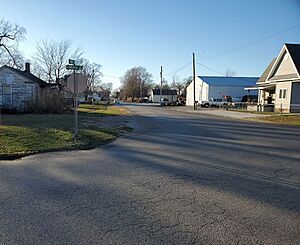Summum, Illinois facts for kids
Quick facts for kids
Summum, Illinois
|
|
|---|---|

View down Sand Branch Road in Summum.
|
|
| Country | United States |
| State | Illinois |
| County | Fulton |
| Elevation | 623 ft (190 m) |
| Time zone | UTC-6 (Central (CST)) |
| • Summer (DST) | UTC-5 (CDT) |
| Area code(s) | 309 |
| GNIS feature ID | 419359 |
Summum is a small community located in Fulton County, Illinois, in the United States. It's right next to U.S. Highway 24, northeast of Astoria, within Woodland Township.
Summum is also known for a special type of coal found nearby, called "Summum coal." This coal layer stretches across much of western Illinois, but it's usually only a few inches thick. However, near Summum, this coal was thick enough to be mined. A strip mine operated here from 1948 to 1955. It was run first by Key Coal Company, then by Peabody Coal Company. After the mining stopped, the area was turned into a small lake.
A famous person from Summum is the country musician and comedian Smiley Burnette, who was born there in 1911.
Discovering Summum's Past
Summum got its name from an early post office. The post office was named after its first postmaster, Peter Summy. The town itself was officially planned in 1851 by James Madison Onion, who owned a local mill. He named the planned town "Oberlin," but people kept using the name Summum.
In the late 1800s, Summum was a busy place with about 200 people. It had three churches and several stores. Today, not many signs of that busy past remain.
The Mystery of Fay Rawley's Disappearance
Summum and its old coal mine became famous across the country in 1953. This happened when a wealthy local farmer and businessman named Fay Rawley disappeared. Rawley lived across the road from the coal mine. His car was seen parked there on the last night he was known to be alive. Many people thought he might have been murdered.
Rawley's disappearance led to a huge search that lasted for years. Virgil Ball, who became the Fulton County Sheriff in 1954, led the search. They focused on the old strip mine. Thousands of curious people came to watch, and news reporters from all over the country covered the story. A large digging machine, called a dragline excavator, was used to dig a 150-foot opening. People believed Rawley's car might have been buried by the mining work. But neither Rawley's car nor his body was ever found. The search was finally stopped in 1957.
In 1962, the search started again for a short time. This time, bulldozers were used, and Sheriff Ball (who was no longer sheriff) even helped pay for it. However, the search stopped when their drill hit a large metal object. Peabody Coal, the company that owned the mine, asked them to stop. They were worried about legal problems if Rawley's body was found on their land. The mystery of Fay Rawley's disappearance remains unsolved.



